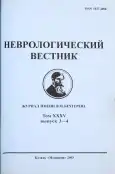Evaluation of the role of magnetic resonance imaging in the diagnosis of localization of herniated intervertebral discs in lumbar osteochondrosis
- Authors: Ablyazov O.V.1, Shokirov E.A.1, Khudoiberdiev K.T.1, Khamraev R.B.1
-
Affiliations:
- Andijan State Medical Institute of the Ministry of Health of Uzbekistan
- Issue: Vol XXXV, No 3-4 (2003)
- Pages: 79-80
- Section: Experience exchange
- URL: https://journals.rcsi.science/1027-4898/article/view/100167
- DOI: https://doi.org/10.17816/nb100167
- ID: 100167
Cite item
Full Text
Abstract
Degenerative-dystrophic lesions in the lumbar spine are most pronounced at the age of 20 to 70 years and are one of the most common causes of temporary disability and often disability of the patient. Herniated intervertebral discs are the most severe manifestations of osteochondrosis of the spine. Radiation diagnostic methods and magnetic resonance imaging (MRI) are of great importance in recognizing herniated intervertebral discs. The advantages of MRI are non-invasiveness, the complete absence of radiation exposure, the possibility of obtaining a multiplanar image, unsurpassed contrast of soft tissues, the absence of artefacts from bone tissues, etc.
Keywords
Full Text
##article.viewOnOriginalSite##About the authors
O. V. Ablyazov
Andijan State Medical Institute of the Ministry of Health of Uzbekistan
Author for correspondence.
Email: info@eco-vector.com
Russian Federation, Andijan
E. A. Shokirov
Andijan State Medical Institute of the Ministry of Health of Uzbekistan
Email: info@eco-vector.com
Russian Federation, Andijan
K. T. Khudoiberdiev
Andijan State Medical Institute of the Ministry of Health of Uzbekistan
Email: info@eco-vector.com
Russian Federation, Andijan
R. B. Khamraev
Andijan State Medical Institute of the Ministry of Health of Uzbekistan
Email: info@eco-vector.com
Russian Federation, Andijan
References
Supplementary files






